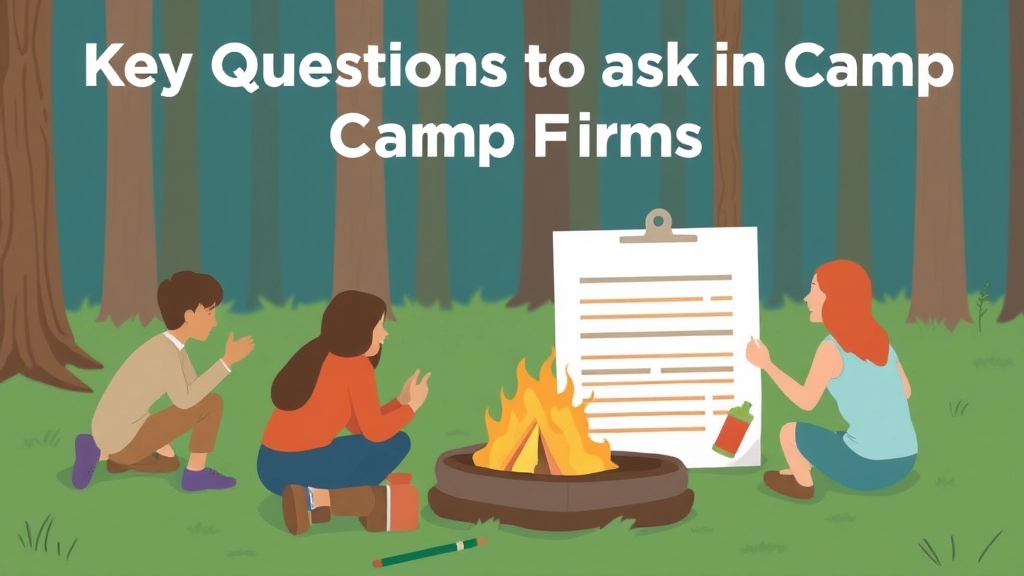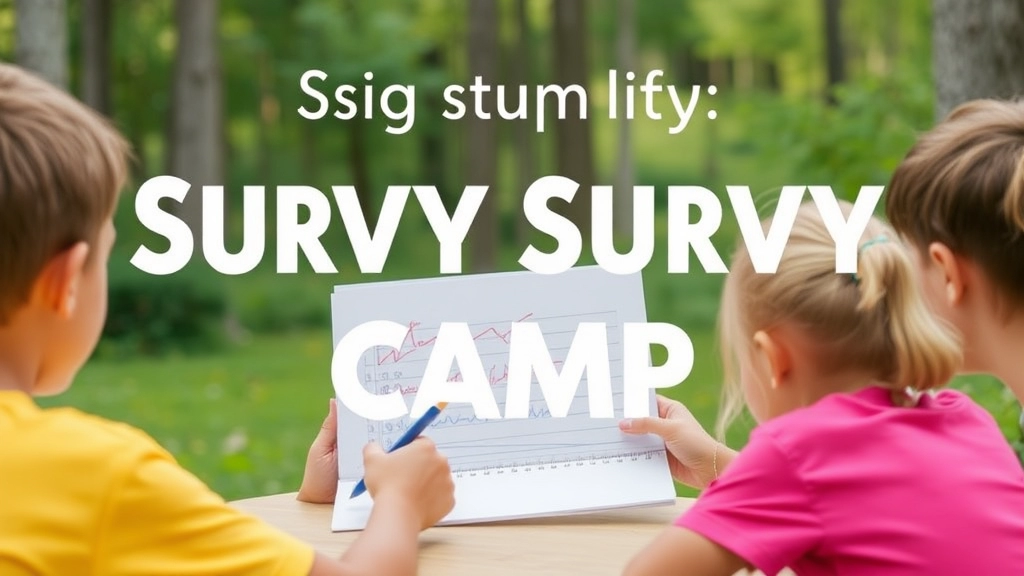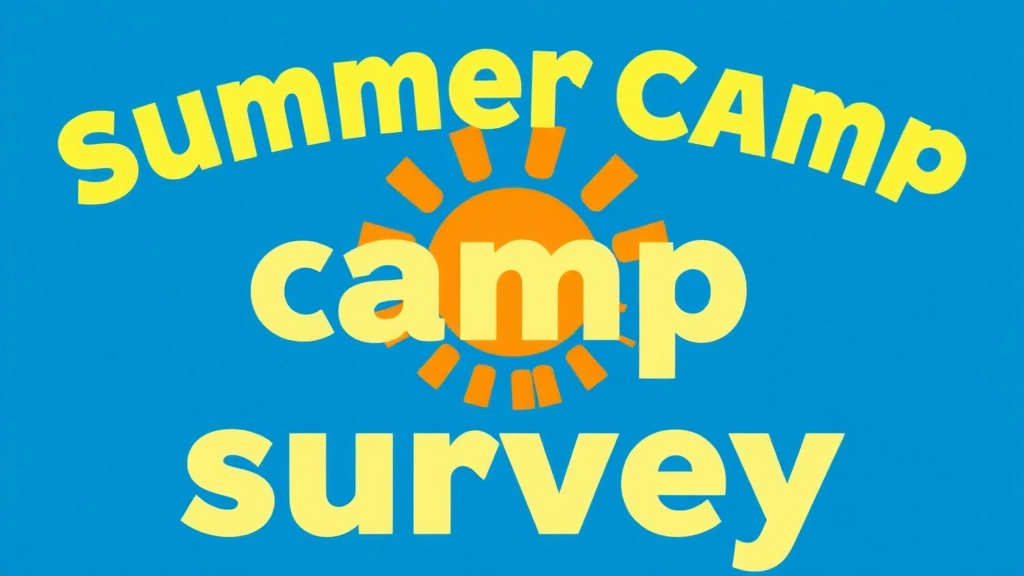Creating a Summer Camp Survey
Creating a summer camp survey is essential for gathering valuable feedback from campers, parents, and staff. Whether you’re looking to evaluate the overall experience, assess specific activities, or improve facilities, a well-designed survey can provide the insights needed to enhance future camps. In this guide, I’ll walk you through the key steps to designing effective summer camp surveys that are both engaging and informative.
Key Steps to Designing Effective Surveys
First, it’s crucial to ask the right questions. Focus on areas like camper satisfaction, activity preferences, and staff performance. Tailoring your questions to the unique aspects of your camp will yield more actionable feedback. Additionally, consider using online platforms for easy distribution and data collection.
Benefits of Online Platforms
By leveraging these tools, you can streamline the process and ensure higher participation rates. Let’s dive into the details and make your next summer camp survey a success!
Designing Effective Summer Camp Surveys
Are you struggling to get useful feedback from your summer camp surveys? You’re not alone. Many camp organisers find it challenging to design surveys that actually provide actionable insights. But don’t worry, I’ve got your back. Let’s dive into how you can design effective summer camp surveys that will help you improve your camp programs and make your campers and their parents happier.
Why Effective Surveys Matter
First off, let’s talk about why designing an effective survey is crucial. If your survey is too long, too complicated, or just plain boring, no one is going to complete it. And if they do, you might end up with half-hearted answers that don’t really help you.
So, how do we avoid that?
Keep It Simple and Focused
Your goal should be to make the survey easy to complete and focused on the most important areas. Here’s how you can do that:
- Limit the number of questions: Aim for 10-15 questions max. Any more, and people will start to lose interest.
- Use a mix of question types: Incorporate multiple-choice, rating scales, and open-ended questions to keep things interesting.
- Prioritise key areas: Focus on questions that will give you the most valuable feedback. Think about what you really need to know to improve your camp.
Make It Engaging
No one likes filling out boring surveys. Make it engaging by:
- Using conversational language: Write your questions like you’re talking to a friend.
- Adding visuals: If possible, include images or icons to make the survey more visually appealing.
- Incentivising completion: Offer a small reward for completing the survey, like a discount on next year’s camp or a free camp T-shirt.
Real Questions, Real Concerns
Address the real questions and worries your audience faces. For example:
- “Did your child feel safe and happy at camp?”
- “What activities did your child enjoy the most?”
- “How can we make the camp experience better for you and your child?”
Example: The Johnson Family
Imagine the Johnson family just finished a week at your summer camp. They had a good time, but there were a few hiccups. Maybe the food wasn’t great, or the activities weren’t as exciting as they had hoped. By asking the right questions in your survey, you can get this valuable feedback and make improvements for next year.
Bullet Points and Lists
Break down complex tips into bullet points and lists for easy reading:
- Ask about specific activities: “How would you rate the archery class?”
- Inquire about staff: “Were the camp counsellors helpful and friendly?”
- Check logistics: “Was the check-in/check-out process smooth?”
For more tips on making your summer camp a success, check out our affordable summer camp assistance for families and our guide on summer camp registration forms.
Key Questions to Ask in Camp Feedback Forms

Alright, let’s dive into the nitty-gritty of camp feedback forms.
We all know how crucial feedback is, right? It’s the backbone of improvement. But what are the key questions you should be asking?
What Did You Enjoy the Most?
First up, ask campers and parents what they enjoyed the most.
- Activities they loved
- Favourite moments
- Standout staff members
This helps you know what’s working. Keep doing more of that!
What Could Be Improved?
Flip the coin. Ask them what needs a bit of tweaking.
- Activities that fell flat
- Facilities that need an upgrade
- Any hiccups in the schedule
This is your goldmine for making next summer even better.
How Did You Find the Staff?
Staff can make or break the camp experience.
- Were they friendly and helpful?
- Did they handle issues well?
- Any standout staff members?
Knowing this helps you train your team better.
How Was the Communication?
Communication is key, especially with parents.
- Was the information clear?
- Did you feel informed?
- How was the check-in/check-out process?
If parents are happy, they’re more likely to send their kids back.
How Was the Safety and Cleanliness?
Safety first, right?
- Did you feel safe?
- Were the facilities clean?
- Any incidents?
This is non-negotiable. You need to nail this down.
Would You Recommend Us?
The ultimate litmus test.
- Would you recommend our camp to others?
- Why or why not?
If they say yes, you’re doing something right. If not, dig deeper.
Any Additional Comments?
Always leave room for open feedback.
- Anything else you want to share?
- Any suggestions or ideas?
Sometimes the best insights come from open-ended questions.
Real Talk
Picture this: You’re chatting with a parent over coffee. They tell you their kid loved the arts and crafts but thought the swimming pool was too crowded. They mention how friendly the counsellors were but felt the communication could be better.
That’s the kind of feedback you’re after.
Keep it real, keep it fresh, and keep it engaging.
Collecting Feedback from Campers and Parents
Ever wondered why some summer camps get rave reviews while others barely get a nod? It’s all about collecting feedback, my friend. If you’re not asking campers and parents what they think, you’re missing the boat. Trust me, this is the real deal.
Why Feedback Matters
First off, let’s get real. Feedback is your golden ticket to improving your camp. Without it, you’re flying blind. You need to know what works, what doesn’t, and what needs tweaking. This isn’t rocket science, but it is crucial.
Real Questions, Real Concerns
Parents worry about safety, activities, and whether their kids are having fun. Campers? They’re all about the fun factor and making friends. So, when you’re collecting feedback, you need to hit these points:
- Safety Concerns: “Did you feel safe throughout the camp?”
- Activity Satisfaction: “Which activities did you enjoy the most?”
- Social Experience: “Did you make new friends?”
Methods to Collect Feedback
Now, let’s break this down. You can’t just throw a survey at them and hope for the best. Here are some tried and true methods:
- Online Surveys: Easy to distribute and analyse. Use platforms like SurveyMonkey or Google Forms.
- Paper Surveys: Old school but effective, especially for younger kids who might not have access to a computer.
- Face-to-Face Interviews: Get personal. Sometimes a one-on-one chat can reveal insights you’d never get from a form.
- Focus Groups: Gather a small group of parents or campers and dive deep into their experiences.
Timing is Everything
When you ask for feedback is just as important as how you ask. Here’s the sweet spot:
- End-of-Camp Surveys: Right when the experience is fresh in their minds.
- Mid-Camp Check-ins: A quick pulse check to make immediate improvements.
- Post-Camp Follow-ups: A few weeks after camp ends to get a more reflective response.
Making it Easy and Engaging
No one wants to fill out a boring survey. Make it engaging:
- Keep it Short: No one has time for a 50-question monstrosity.
- Use Visuals: Emojis, star ratings, and images can make the process more fun.
- Offer Incentives: A little bribery never hurt anyone. A small prize or discount on next year’s camp can go a long way.
Real-Life Example
Let me tell you about Camp Sunshine. They started using mid-camp check-ins and saw a 30% increase in camper satisfaction. Parents loved the end-of-camp surveys because they felt their concerns were heard and addressed. The result? A fully booked camp for the next summer.
For more on how to keep your summer camp safe and enjoyable, check out our Summer Camp Safety Essential Guidelines and learn about Effective Summer Camp Marketing Strategies to keep your camp thriving.
Using Survey Results to Improve Camp Programs

Alright, let’s get real.
We all want to run the best summer camp out there, right?
But how do we know what’s working and what’s not?
Survey results.
Yep, those feedback forms aren’t just paperweights—they’re gold mines of information.
Why Bother with Survey Results?
First off, let’s address the elephant in the room.
Why even bother with survey results?
Here’s the deal:
- Pinpoint Weaknesses: Find out exactly where campers and parents think you could step up your game.
- Highlight Strengths: Know what you’re doing right so you can keep doing it.
- Stay Competitive: Use the data to stay ahead of other camps.
Turning Feedback into Action
Got the survey results?
Great.
Now, what do you do with them?
- Categorise Feedback: Split the feedback into categories like activities, food, staff, and facilities.
- Prioritise Issues: Not all problems are created equal. Focus on the ones that come up the most.
- Create an Action Plan: Make a to-do list based on the feedback. Simple as that.
Real-World Example
Let me share a quick story.
Last summer, we noticed a lot of feedback about our camp’s dining options.
Kids loved the activities but weren’t too thrilled about the food.
So, we revamped the menu, brought in a new chef, and guess what?
The next round of surveys showed a 50% increase in satisfaction with meals.
Keeping It Fresh
Remember, the goal is to keep improving.
So, don’t just collect feedback once and call it a day.
Make it a regular thing.
- Quarterly Reviews: Go through the feedback every few months.
- Staff Meetings: Discuss the results with your team.
- Update Your Action Plan: Keep tweaking and improving.
Best Platforms for Creating Camp Surveys
Alright, let’s talk about the best platforms for creating camp surveys. This is a big deal because choosing the right one can make or break your feedback process. You want something that’s easy to use, reliable, and gives you all the data you need to make your summer camp the best it can be. So, let’s dive in.
Why the Right Platform Matters
Ever been frustrated with clunky survey tools that make you want to pull your hair out? Yeah, me too. The right platform can streamline the entire process, making it easier for you to create, distribute, and analyze surveys. Plus, it can increase participation rates because people actually enjoy using it.
Top Platforms to Consider
SurveyMonkey
- Ease of Use: Super user-friendly with drag-and-drop features.
- Customisation: Tons of templates and customisation options.
- Analytics: Provides detailed reports and analytics.
- Integration: Works well with other tools like MailChimp and Google Sheets.
Google Forms
- Cost: Completely free.
- Accessibility: Easy to share via email or link.
- Simplicity: Straightforward and easy to set up.
- Integration: Automatically stores responses in Google Sheets for easy analysis.
Typeform
- Design: Beautiful, engaging forms that feel like a conversation.
- User Experience: Smooth and interactive, which can boost completion rates.
- Customisation: Highly customisable with various question types.
- Analytics: Offers real-time data and insights.
JotForm
- Templates: A vast library of templates to get you started.
- Flexibility: Highly customisable with various widgets and apps.
- Integration: Integrates with payment processors, CRMs, and more.
- Ease of Use: Intuitive interface that’s easy to navigate.
Zoho Survey
- Cost: Affordable pricing plans.
- Features: Offers advanced features like skip logic and piping.
- Integration: Works well with other Zoho products and third-party apps.
- Analytics: Provides detailed reporting and analytics.
Real Concerns and How These Platforms Address Them
“I don’t have time to create a survey from scratch.”
Solution: Most of these platforms offer pre-made templates that you can tweak to fit your needs. SurveyMonkey and JotForm, for example, have extensive libraries of templates specifically designed for camp surveys.
“I need detailed analytics to make informed decisions.”
Solution: Platforms like SurveyMonkey and Typeform offer robust analytics tools that can help you dig deep into the data. You can see trends, pinpoint areas for improvement, and even segment responses for more targeted insights.
“I want to make the survey engaging so more people complete it.”
Solution: Typeform excels in this area. Its conversational style makes the survey experience more enjoyable, which can lead to higher completion rates.
Making Your Choice
So, which platform should you choose? It really depends on your specific needs. If you’re looking for something free and easy, Google Forms is a solid choice. If you want advanced features and are willing to pay for them, SurveyMonkey or Typeform might be better options. And if you need a lot of customisation and integration capabilities, JotForm could be your best bet.
Choosing the right platform for creating camp surveys can make a huge difference in how effective your feedback process is. Whether you go with SurveyMonkey, Google Forms, Typeform, JotForm, or Zoho Survey, the key is to pick one that aligns with your needs and makes the process as smooth as possible. Trust me, your future selfâand your campersâwill thank you.
For more ideas on engaging activities and lesson plans, check out our Summer Camp Lesson Plans. And if you need some creative inspiration for camp crafts, don’t miss our Summer Camp Crafts section.
Strategies to Increase Survey Participation

Alright, let’s get real: How do we get more people to fill out these summer camp surveys?
It’s a common worry. You’ve spent time crafting the perfect survey, but if no one completes it, what’s the point?
Here’s how we can boost those participation rates:
1. Keep It Short and Sweet
No one has the time or patience for a 20-minute survey.
- Aim for 5-10 minutes max.
- Only ask what you need to know.
2. Incentivise Participation
People love free stuff.
- Offer a small reward like a discount on next year’s camp or a chance to win a gift card.
- Make it clear what they get for their time.
3. Send Reminders
Life gets busy. A friendly nudge can go a long way.
- Send a reminder email a few days after the initial request.
- Use different channels like texts or social media to remind them.
4. Make It Mobile-Friendly
Everyone’s on their phones these days.
- Ensure your survey works smoothly on mobile devices.
- Test it yourself to catch any glitches.
5. Personalise Your Requests
Generic emails get ignored.
- Use their names in your emails.
- Mention specific experiences they had at camp.
6. Timing Is Everything
Catch them at the right moment.
- Send out surveys soon after camp ends while memories are fresh.
- Avoid busy times like holidays or the start of the school year.
7. Share the Impact
Show them their feedback matters.
- Let them know how their input will improve the camp.
- Share past changes made based on survey results.
8. Simplify the Process
Make it as easy as pie.
- Use clear, simple language.
- Avoid jargon and complex questions.
9. Use Engaging Formats
Make it fun.
- Use visuals like images or emojis.
- Include interactive elements like sliders or rating scales.
10. Be Transparent
Honesty builds trust.
- Explain why you’re collecting feedback.
- Assure them their responses are confidential.
Real Talk
Imagine you’re chatting with a friend over coffee. They’re more likely to help you out if you make it easy and show you care about their opinion.
So, next time you’re crafting that survey, think about these strategies.
You’ll see those participation rates climb, and your camp will get the valuable insights it needs.
Automating the Survey Process for Efficient Data Collection
Ever wondered how to make the survey process less of a headache and more of a breeze? Automating the survey process could be your golden ticket. The keyword here is “automating the survey process,” and trust me, it’s a game-changer.
Why Automate?
Let’s be real, manually collecting and analysing feedback is a colossal time sink. Here’s what keeps camp directors up at night:
- How do I get more parents and campers to fill out surveys?
- How can I quickly analyse all this data?
- Is there a way to make this whole process less tedious?
Automation can tackle these worries head-on. Imagine a system that sends out surveys, collects responses, and even analyses the data for you. Sounds dreamy, right?
The Benefits of Automation
Automating the survey process isn’t just about saving time. It’s about boosting efficiency and getting more accurate insights. Here’s how:
- Consistency: Automated systems ensure you’re asking the same questions in the same way every time.
- Speed: Responses are collected and analysed in real-time.
- Reach: Automated emails and reminders can significantly increase participation rates.
- Accuracy: Reduced human error in data collection and analysis.
How to Automate Your Surveys
Okay, so you’re sold on the idea. But how do you actually go about automating the survey process? Here’s a step-by-step guide:
- Choose the Right Platform: Look for survey tools that offer automation features. Some of the best platforms include SurveyMonkey, Google Forms, and Typeform.
- Set Up Triggers: Use triggers to send surveys automatically. For example, send a survey to parents and campers right after the camp ends.
- Customise Your Surveys: Tailor your questions to fit different camp types. Use conditional logic to make surveys more engaging and relevant.
- Automate Reminders: Set up automated email reminders for those who haven’t completed the survey. This can drastically improve your response rates.
- Integrate with Other Tools: Link your survey platform with other tools like CRM systems or email marketing software for seamless data transfer and analysis.
Real-Life Example
Let’s say you run a summer camp for kids aged 8-12. You use SurveyMonkey to create a feedback form. You set it up so that an email with the survey link is automatically sent to parents the day after the camp ends. Two days later, an automated reminder email goes out to those who haven’t filled it out yet. The responses start rolling in, and SurveyMonkey’s analytics tools give you instant insights into what worked and what didn’t.
Keeping It Fresh
The key to making this work is to keep your surveys fresh and engaging. Here are some tips:
- Use Simple Language: Keep questions straightforward and easy to understand.
- Be Concise: No one wants to fill out a 50-question survey. Aim for 10-15 questions max.
- Add a Personal Touch: Use the camper’s name in the survey to make it feel more personalised.
- Include Fun Elements: Add emojis, images, or even short video clips to make the survey more engaging.
Automating your survey process can be a game-changer, especially when you’re juggling multiple tasks at a summer camp. For more tips on how to keep your campers cool and comfortable during the summer, check out our best tips. And if you’re looking for engaging activities to keep the fun going, explore our guide on fun activities at summer camp.
Analyzing Survey Data to Identify Strengths and Weaknesses

Alright, let’s dive into the nitty-gritty of analyzing survey data to identify strengths and weaknesses.
Ever wondered if your camp is hitting the mark?
Or maybe you’re scratching your head over what’s falling flat?
You’re not alone.
1. Start with the Basics
First, get all your data in one place.
I like to use a spreadsheet.
Simple, right?
2. Break It Down
Look at the feedback from different angles:
- Overall satisfaction: Are campers and parents happy?
- Specific activities: Which ones are a hit? Which ones are a miss?
- Facilities and staff: Any complaints or praises?
3. Use Visuals
Graphs and charts can make your life easier.
A quick bar graph can show you which activities are loved and which need improvement.
4. Look for Patterns
Is there a common thread in the feedback?
Maybe everyone loves the swimming sessions but hates the food.
5. Categorise Feedback
- Positives: What are you doing well? Keep at it.
- Negatives: What needs fixing? Prioritise these.
- Suggestions: Any new ideas? Consider them for future camps.
6. Get Specific
Don’t just look at the numbers.
Read the comments.
They’ll give you context.
7. Compare with Past Data
If you’ve done surveys before, compare the results.
Are things getting better or worse?
8. Actionable Insights
Turn your findings into actions:
- Improve weak areas
- Boost strong points
- Implement new ideas
Quick Story Time
Last year, we found out our arts and crafts sessions were a flop.
Kids were bored.
Parents were unimpressed.
We revamped it with new materials and more engaging activities.
This year?
It’s one of our top-rated sessions.
Final Thoughts
Analyzing survey data isn’t just about numbers.
It’s about understanding what’s working and what’s not.
Keep it real.
Keep it actionable.
And always aim to improve.
Customising Surveys for Different Camp Types
Ever wondered why some summer camp surveys hit the mark while others fall flat? Customising your surveys for different camp types can make all the difference. Whether you’re running a sports camp, an arts camp, or a tech camp, tailoring your questions to fit the specific context is crucial. Let’s dive into how we can make your surveys more effective and engaging.
Know Your Audience
First things first, who are you asking? The questions for a sports camp might not be relevant for a science camp. It’s like trying to fit a square peg into a round hole. Here’s how you can break it down:
- Sports Camps: Focus on physical activities, coaching quality, and facilities.
- Arts Camps: Dive into creativity, instructor feedback, and material availability.
- Tech Camps: Ask about the tech tools, coding projects, and gadget access.
Example: For a sports camp, ask, “How would you rate the quality of the coaching staff?” For a tech camp, you might ask, “Were the coding workshops helpful and easy to follow?”
Tailor the Questions
Generic questions won’t cut it. You need specifics. Let’s say you run an adventure camp. Asking about the dining experience is fine, but what about the thrill of the zip line or the safety of rock climbing?
- Adventure Camps: “How did you feel about the safety measures during rock climbing?”
- Music Camps: “Was the selection of instruments adequate for your learning?”
Use Real-Life Scenarios
Imagine this: You’re a parent sending your child to a tech camp. You’d want to know if the instructors made complex topics understandable, right? So, ask that!
- Tech Camps: “Did the instructors simplify complex coding topics effectively?”
- Cooking Camps: “Were the recipes easy for children to follow and recreate at home?”
Keep It Engaging
No one likes boring surveys. Keep them lively and straightforward. Use a mix of multiple-choice questions, ratings, and open-ended questions.
- Multiple Choice: “Which activity did you enjoy the most? (A) Coding (B) Robotics (C) Game Design”
- Ratings: “Rate the quality of the camp meals from 1 to 5.”
- Open-Ended: “What was your favourite part of the camp and why?”
Real Stories, Real Feedback
Let’s keep it real. Share stories or examples to make the survey relatable. For instance, if a camper loved the arts and crafts session, ask them to describe their favourite project.
- Arts Camps: “Describe your favourite art project and what you enjoyed about it.”
- Sports Camps: “Share a memorable moment from a game or practice session.”
Simplify and Streamline
Don’t overcomplicate it. The easier it is to complete, the more responses you’ll get. Use clear, simple language and avoid jargon.
- Simple Language: “Did you enjoy the camp activities?” instead of “Were the recreational activities satisfactory?”
- Streamlined Format: Use bullet points, lists, and bold highlights to make it skimmable.
For more tips on creating engaging camp experiences, check out our Ultimate Summer Camp Planning Checklist and explore our Summer Camp Schedule and Activities Guide.
Tips for Making Surveys Engaging and Easy to Complete
Ever find yourself staring at a survey that feels more like a chore than a conversation?
Yeah, me too.
Let’s make sure our summer camp surveys aren’t like that.
Here’s the game plan:
Start with a Bang
- Hook them in the first line.
- “What did you love most about camp this summer?”
- Get them talking about their best moments right away.
Keep it Short and Sweet
- Brevity is your friend.
- Aim for no more than 10 questions.
- If it feels long, it probably is.
- Mix it up.
- Use a blend of multiple-choice, rating scales, and open-ended questions.
- Keeps the brain engaged and prevents survey fatigue.
Be Conversational
- Write like you talk.
- Imagine you’re chatting with a friend over coffee.
- No jargon, no fluff.
- Example:
- Instead of “Rate your satisfaction with the camp facilities,” say “How did you find the camp facilities?”
Add Some Fun
- Inject a bit of personality.
- Throw in a light-hearted question or two.
- “If our camp were a movie, what genre would it be?”
- Use visuals.
- Emojis, images, and icons can make a survey feel less like a test and more like a game.
Make It Mobile-Friendly
- Everyone’s on their phones.
- Ensure your survey looks good and works well on mobile devices.
- Test it out yourself to be sure.
Offer Incentives
- Give them a reason to complete it.
- Maybe a small prize draw or a discount on next year’s camp.
- People love freebies.
Be Transparent
- Tell them why their feedback matters.
- “Your answers help us make next year’s camp even better!”
- People like to know their opinion counts.
Real-Life Example
- Story Time:
- Last year, we asked our campers what their favourite activity was.
- The overwhelming response was a surprise â they loved the evening campfires.
- This year, we made sure to have more of those, and guess what? Satisfaction scores shot through the roof.
Wrap It Up with a Thank You
- Finish strong.
- “Thanks for sharing your thoughts! We can’t wait to see you next summer.”
- Leave them with a positive feeling.
In the end, it’s all about making it easy and fun for them to share their thoughts.
Engaging surveys lead to better feedback, and better feedback leads to an even better camp experience.
For more insights on creating a memorable camp experience, check out our Summer Camp Packing Essential Tips and Tricks and learn how to Maximize Your Basketball Summer Camp Experience.
FAQs on Summer Camp Survey
Why is collecting feedback from camp surveys important?
Feedback is crucial as it serves as the backbone of improvement. It helps pinpoint what works and what needs improvement in your camp programs.
What are some key questions to include in a camp feedback form?
Key questions should cover what campers and parents enjoyed the most, what could be improved, the quality of staff interactions, communication effectiveness, safety and cleanliness, and whether they would recommend the camp.
How can I effectively use survey results to improve camp programs?
Survey results can help pinpoint weaknesses, highlight strengths, and keep your camp competitive. Categorise feedback, prioritise issues, and create an actionable plan based on the feedback.
What strategies can increase survey participation?
To increase survey participation, keep the survey short, offer incentives, send reminders, make it mobile-friendly, personalise requests, time it well, share the impact of feedback, simplify the process, use engaging formats, and be transparent about the purpose of the survey.
How can I analyse survey data to identify strengths and weaknesses?
Start by gathering all data in one place, break it down into different categories, use visuals like graphs, look for patterns, categorise feedback into positives, negatives, and suggestions, get specific with comments, compare with past data, and turn findings into actionable insights.
What should I do with the feedback collected from surveys?
Categorise the feedback into activities, food, staff, and facilities. Prioritise the issues that come up most frequently and create an action plan to address them. Regularly review and update your action plan based on ongoing feedback.
How can I ensure the feedback process is ongoing and effective?
Make feedback collection a regular process, review feedback quarterly, discuss results with your team, and continuously update your action plan to keep improving the camp experience.
Can you give an example of how feedback has improved a camp program?
For instance, if feedback highlighted dissatisfaction with dining options, you could revamp the menu and bring in a new chef. This could lead to a significant increase in satisfaction with meals, as shown in subsequent surveys.
What are some common mistakes to avoid when creating a camp survey?
Avoid making the survey too long, using complex language or jargon, sending it out at inconvenient times, and failing to communicate the importance and impact of the feedback.
How can I make the survey process more engaging for respondents?
Use visuals like images or emojis, include interactive elements like sliders or rating scales, and ensure the survey is easy to understand and complete.
References
-
The Importance of Surveys in Camp
-
Using Surveys to Improve Camp Experience
-
5 Ways to Increase Survey Response Rates

